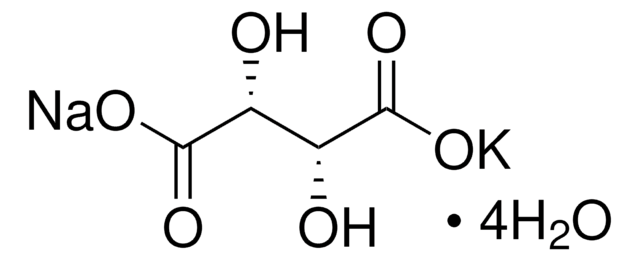675636
Cupferron
97%, reagent grade
Synonym(s):
N-Nitroso-N-phenylhydroxylamine ammonium salt
About This Item
Recommended Products
grade
reagent grade
Assay
97%
form
solid
technique(s)
titration: suitable
mp
150-155 °C (dec.) (lit.)
shipped in
wet ice
storage temp.
2-8°C
SMILES string
[H][N+]([H])([H])[H].[O-]N(N=O)c1ccccc1
InChI
1S/C6H5N2O2.H3N/c9-7-8(10)6-4-2-1-3-5-6;/h1-5H;1H3/q-1;/p+1
InChI key
GDEBSAWXIHEMNF-UHFFFAOYSA-O
Looking for similar products? Visit Product Comparison Guide
Related Categories
General description
Application
- A solvothermal route to ZnO and Mn-doped ZnO nanoparticles using the cupferron complex as the precursor.: This research presents a novel method to produce zinc oxide and manganese-doped zinc oxide nanoparticles using cupferron as a precursor, showcasing its application in material synthesis in analytical chemistry (Ghosh et al., 2004).
- Determination of tellurium in geochemical materials by flameless atomic-absorption spectroscopy.: Demonstrates the role of cupferron in enhancing the analytical methodologies for tellurium determination, underpinning its significance in geochemical studies (Sighinolfi et al., 1979).
- Extraction of vanadium into isobutyl methyl ketone.: Outlines a method for extracting vanadium using cupferron, which plays a crucial role in the development of methods for the quantitative analysis of vanadium in various samples (Crump-Wiesner and Purdy, 1969).
- Substituted hydroxylamines as analytical reagents.: Discusses the application of substituted hydroxylamines, including cupferron, as reagents in chemical analysis, illustrating the compound′s adaptability and utility in analytical chemistry (Shendrikar, 1969).
Signal Word
Danger
Hazard Statements
Precautionary Statements
Hazard Classifications
Acute Tox. 3 Oral - Carc. 1B - Eye Irrit. 2 - Muta. 2 - STOT SE 3
Target Organs
Respiratory system
Storage Class Code
6.1C - Combustible acute toxic Cat.3 / toxic compounds or compounds which causing chronic effects
WGK
WGK 3
Personal Protective Equipment
Choose from one of the most recent versions:
Already Own This Product?
Find documentation for the products that you have recently purchased in the Document Library.
Customers Also Viewed
Our team of scientists has experience in all areas of research including Life Science, Material Science, Chemical Synthesis, Chromatography, Analytical and many others.
Contact Technical Service












